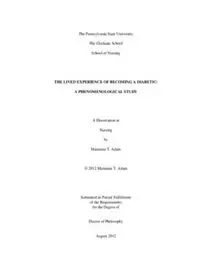
THE LIVED EXPERIENCE OF BECOMING A DIABETIC: A PHENOMENOLOGICAL STUDY PDF
Preview THE LIVED EXPERIENCE OF BECOMING A DIABETIC: A PHENOMENOLOGICAL STUDY
The Pennsylvania State University The Graduate School School of Nursing THE LIVED EXPERIENCE OF BECOMING A DIABETIC: A PHENOMENOLOGICAL STUDY A Dissertation in Nursing by Marianne T. Adam © 2012 Marianne T. Adam Submitted in Partial Fulfillment of the Requirements for the Degree of Doctor of Philosophy August 2012 The dissertation of Marianne T. Adam was reviewed and approved* by the following: Carol A. Smith Associate Professor School of Nursing Dissertation Advisor Chair of Committee Judith E. Hupcey Associate Dean for Graduate Education School of Nursing Robert A. Gabbay Professor of Medicine and Endocrinology Penn State Hershey College of Medicine Edward W. Taylor Professor of Adult Education *Signatures are on file in the Graduate School ii ABSTRACT Type 2 diabetes mellitus is a chronic disease that affects an estimated 25.8 million persons or 8.3% of the U.S. population, who are at high risk for major health complications (CDC, 2011; NDIC, 2012). Control of the disease depends largely on the diabetic’s adoption of self-care and health management strategies designed to control serum glucose levels. Diabetes Self-Management Education (DSME) is one process recommended to facilitate health behavior change and usually an expectation for the person recently diagnosed. However, outcomes of the formalized DSME programs are inconsistent and the overall process of self-care learning in the context of a recent diagnosis of diabetes is poorly understood. The purpose of this phenomenological study was to enhance the understanding of the initial lived experience of becoming a diabetic. The focus was on the individual’s engagement with learning new self-care activities and initiating changes in self-care commonly recommended in order to control serum glucose and generally manage the disease progression. The focus of the study was not on how learning occurs or is accomplished as a process but rather on uncovering the key elements and the context of the actual experience itself to gain information not previously explored. Using an interpretive phenomenological method of inquiry (van Manen, 1990), this study investigated the lived experience of becoming a diabetic in 10 adults recently diagnosed with type 2 (often referred to as ‘adult onset’) diabetes. The participants (8 females and 2 males) ranged in age from 39 to 77. Most (9) had been diagnosed within 1 to 1.5 years of this study. Analysis of the data obtained from open-ended interviews iii revealed three themes of the lived experience of becoming a diabetic: (a) hearing the news (diagnosis), (b) sorting it out, and (c) moving on. Although these themes framed the experience for all of the participants, they were not in a fixed order. Improved understanding of the experience of becoming a diabetic and responses to the disease, as revealed in this study, provides new insight into how to best support patients in similar situations. Implications for nursing practice, education, and research are also identified. iv TABLE OF CONTENTS List of Tables .........................................................................................................................x Acknowledgements ................................................................................................................xi Chapter 1: Introduction ..........................................................................................................1 Background ......................................................................................................................3 Statement of the Problem .................................................................................................7 Research Questions ..........................................................................................................7 Purpose of the Study ........................................................................................................8 Theoretical Perspective ....................................................................................................8 Significance of the Study .................................................................................................9 Assumptions .....................................................................................................................10 Limitations of the Study...................................................................................................10 Conceptual Terms ............................................................................................................11 Chapter Summary ............................................................................................................12 Chapter 2: Review of the Literature .......................................................................................14 Phenomenology................................................................................................................14 The Preparatory Phase ...............................................................................................15 The German Phase .....................................................................................................16 Husserl .................................................................................................................17 Heidegger .............................................................................................................19 The French Phase .......................................................................................................21 Parallel Development .................................................................................................22 Phenomenological Research and Nursing .................................................................22 v Hermeneutic Phenomenology ....................................................................................23 Adult Learning .................................................................................................................25 Learner-Driven Versus Teacher-Driven Activities ....................................................27 Informal Learning ......................................................................................................31 The Health Belief Model .................................................................................................34 Learning in the Context of Illness ....................................................................................35 Learning and Chronic Illness .....................................................................................36 Learning in the Context of Diabetes ..........................................................................41 Rationale for Using Hermeneutic (Interpretative) Phenomenology ................................51 Chapter Summary ............................................................................................................52 Chapter 3: Research Design and Method...............................................................................55 Participant Sampling ........................................................................................................56 Recruitment ......................................................................................................................59 Data Collection ................................................................................................................59 Data Management ............................................................................................................61 Data Analysis ...................................................................................................................61 Human Subjects Protection ..............................................................................................67 Conclusion .......................................................................................................................68 Chapter 4: Study Results and Analysis ..................................................................................70 The Study Participants .....................................................................................................70 Participant #1: Pam ....................................................................................................72 Participant #2: Sally ...................................................................................................72 Participant #3: Lenny ................................................................................................73 vi Participant #4: Debbie................................................................................................73 Participant #5: Martin ................................................................................................74 Participant #6: Karen .................................................................................................74 Participant #7: Diane .................................................................................................75 Participant #8: Jane....................................................................................................75 Participant #9: Cathy..................................................................................................76 Participant #10: Carol ................................................................................................76 Identification of Themes ..................................................................................................77 Analysis of the Themes ....................................................................................................79 Hearing the News .......................................................................................................80 Hearing the News: Blocking the Message ...........................................................80 Hearing the News: Reflecting on the Past ...........................................................83 Hearing the News: Fear of “Knowing” ................................................................86 Existential Themes When Hearing the News ............................................................90 Sorting It Out .............................................................................................................92 Sorting It Out: Knowing by Comparison to Others .............................................92 Sorting It Out: Working to Understand and Stay Aware .....................................100 Sorting It Out: Recognizing Support Options ......................................................109 Existential Themes When Sorting It Out ...................................................................118 Moving On .................................................................................................................119 Moving On: Movement Toward a New Reality ..................................................120 Moving On: Choosing Action Versus Inaction ...................................................127 Moving On: Achieving a New Level of Awareness ............................................137 vii Existential Themes When Moving On .......................................................................145 Summary of the Findings ...........................................................................................147 Self-Care When Becoming a Diabetic .................................................................147 Medication Management ...............................................................................148 Dietary Management ......................................................................................148 Glucometry ....................................................................................................150 Exercise ..........................................................................................................150 Participants’ View of Complications .............................................................150 Existential Themes When Becoming a Diabetic .......................................................151 Individual Meanings When Becoming a Diabetic .....................................................152 Shared Meaning of the Lived Experience of Becoming a Diabetic...........................155 Conclusion .......................................................................................................................156 Chapter 5: Discussion ............................................................................................................159 Hearing the News .............................................................................................................160 Sorting it Out....................................................................................................................164 Moving On .......................................................................................................................177 Becoming a Diabetic and Learning Principles.................................................................184 Implications for Nursing Practice and Education ............................................................187 Recommendations for Further Research ..........................................................................190 Limitations of the Study...................................................................................................191 Strengths of the Study ......................................................................................................192 Conclusion .......................................................................................................................194 References ..............................................................................................................................196 viii Appendix A: Recruitment Materials ......................................................................................209 Appendix B: Interview Guide ................................................................................................213 Appendix C: IRB Approval ...................................................................................................215 Appendix D: Informed Consent .............................................................................................217 ix LIST OF TABLES Table 4.1. Summary of the Study Participants’ Demographics .........................................71 Table 4.2. Summary of the Primary Themes and Thematic Elements ..............................79 x
